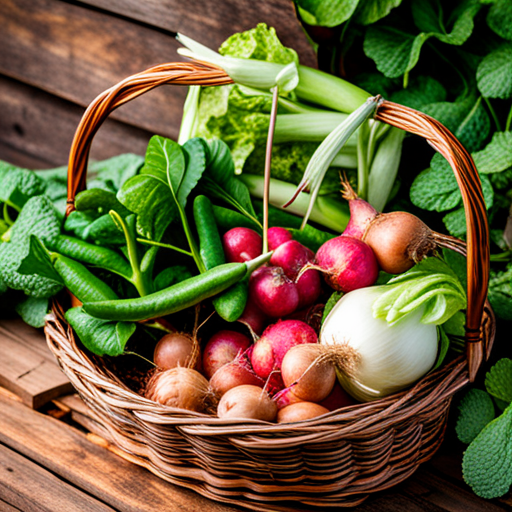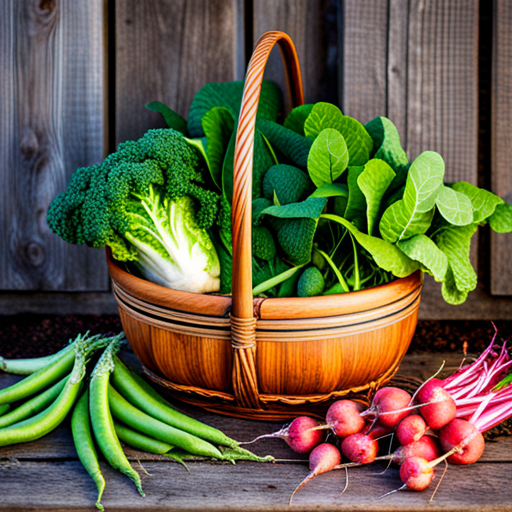
Fall vegetable gardening is a wonderful way to extend your growing season and enjoy a fresh bounty of crisp and flavorful vegetables long after summer has ended. And if you’re fortunate enough to live in the warmer climates of USDA Hardiness Zones 9-10, you can take the lower temps and fall weather as a sign to start planting your veggies. In this blog post, I’ll share the best fall vegetable garden zone 9-10 ideas, how to prepare your soil, what months are best for planting, what vegetables you should consider, and how to nurture and harvest your fall crops.
Preparing your Fall Garden for Planting
First things first, preparing your soil is key to a successful fall harvest. In early September, give your garden a thorough cleaning, removing any weeds and other debris. Then, work in a generous amount of compost or well-rotted manure into your soil. This will help add much-needed organic matter and improve soil quality. Aim for a soil pH level between 6.0-6.5, slightly acidic to neutral.
Favorite Fall Vegetables to Plant for Zone 9-10
When considering what vegetables you want to grow in the fall, there are plenty of options!
For zone 9-10, it’s best to plant cool-season veggies in early October for a harvest in late November or early December. Planting later can still work, but the vegetables may not mature as well due to decreased sunlight hours as the days grow shorter.
Brussels Sprouts: A Must-Have in Your Zone 9-10 Fall Garden
Brussels sprouts are a great green vegetable to grow in zones 9-10 during the fall season. They prefer the cooler temperatures and can even tolerate a light frost. Start planting in September to give them enough time to mature.
For optimum growth, Brussels sprouts require full sun and well-drained soil enriched with compost or well-rotted manure. Keep the soil consistently moist, but avoid water-logged conditions.
Harvesting typically begins 90-100 days after planting. Look for firm, compact sprouts about one inch in diameter. Harvest from the bottom of the stalk upwards, as the lower sprouts mature first.
Cabbage: A Robust Addition to Zone 9-10 Fall Vegetable Gardens
Cabbage is another cool-season crop that does well in zones 9-10, and it’s quite tolerant of frost. Plant cabbage seeds in early September to allow time for maturity before the cooler temperatures of winter set in.
Cabbage plants prefer full sun and soil rich in organic matter. Maintain even soil moisture throughout the growing season but avoid waterlogged conditions.
Harvesting usually occurs 80-180 days after planting, depending on the variety. Harvest when heads are firm and have reached an acceptable size. Simply cut the mature head at the base of the plant.
Carrots: A Versatile Vegetable for Your Zone 9-10 Fall Garden
Carrots are a wonderful vegetable for fall gardens in zones 9-10. They can be sown directly into the soil in September or October.
Carrots prefer a sunny location and loose, sandy soil that allows for proper root development. Water regularly and gently to keep the soil moist.
Carrots can typically be harvested 70-80 days after sowing, but the exact timing can depend on the carrot variety. They can be harvested when young and small, or you can let them grow larger. To harvest, simply pull the entire plant from the ground.
Broccoli: A Nutrient-Rich Option for Your Zone 9-10 Fall Garden
Broccoli is a cool-season crop that flourishes well in zones 9-10. It’s best to plant broccoli seeds in September to ensure they mature before the arrival of cooler temperatures.
Broccoli thrives in full sun and nutrient-rich soil with good drainage. Regular watering to maintain consistently moist soil is essential for its growth.
Harvesting usually occurs 70-100 days after planting. Broccoli is ready for harvest when the green buds of the head are firm and tight, just before the heads flower. Cut the central stem at a slant, about 5-6 inches below the head.
Cauliflower: A Hardy Vegetable for Your Zone 9-10 Fall Garden
Cauliflower is another fantastic fall vegetable for zones 9-10. Plant cauliflower seeds in early September to give them enough time to mature before the colder weather.
Like broccoli, cauliflower prefers full sun and nutrient-rich, well-draining soil. Keep the soil evenly moist with regular watering.
Cauliflower is usually ready to harvest in 85-130 days from planting. When the cauliflower head looks full and dense, it’s typically ready to be harvested. Cut the head off from the main stem, leaving a few leaves around it for protection.
Beets: A Vibrant Addition to Your Zone 9-10 Fall Garden
Beets are a wonderful choice for a fall garden in zones 9-10. They can be directly sown into the soil in September or October.
Beets prefer a sunny spot and soil that is rich in organic material and has good drainage. Water regularly, ensuring the soil remains moist but not waterlogged.
Beets can be harvested as soon as 50-70 days after planting. They can be harvested when small for tender, sweet beets, or left to grow larger for a more robust flavor. To harvest, gently pull the entire beet plant from the ground.
Peas: A Sweet Treat for Your Zone 9-10 Fall Garden
Peas are a delicious and rewarding addition to any fall garden in zones 9-10. They should be sown directly into the soil in September or October.
Peas prefer cooler temperatures and a sunny location with well-drained soil rich in organic material. They also need a trellis or some other form of support as they grow.
Peas can typically be harvested around 60-70 days after planting. They are ready when the pods are firm and bright green. To harvest, simply pluck the pods from the plant.
Radishes: A Crunchy Delight for Your Zone 9-10 Fall Garden
Radishes are a quick and easy choice for a fall garden in zones 9-10. Plant them directly into the soil from September onward.
Radishes prefer full sun or partial shade and well-drained soil. Be sure to water them regularly to keep the soil evenly moist.
Radishes grow quickly and can be ready for harvest as soon as three weeks after planting. When the tops of the radish roots start to peek out of the soil, it is usually a good sign they are ready to be harvested. To harvest, gently pull the entire plant from the ground.
Onions: A Flavorful Staple for Your Zone 9-10 Fall Garden
Onions are a versatile and hearty vegetable to include in your fall garden. For zones 9-10, plant onion sets directly into the soil in September or October.
Onions prefer a location with full sun and well-drained soil rich in organic matter. Water them regularly to keep the soil evenly moist but not waterlogged.
Onions are usually ready to harvest 100-120 days after planting. When the tops of the onions turn yellow and begin to fall over, they are ready to be harvested. To harvest, gently lift the onions from the soil.
Turnips: A Hardy Root Vegetable for Your Zone 9-10 Fall Garden
Turnips are a great choice for a hearty fall vegetable in zones 9-10. They can be direct sown into the soil in September or October.
Turnips prefer a sunny spot and well-drained soil rich in organic material. Water regularly, ensuring that the soil remains evenly moist.
Turnips can be harvested as early as 30-60 days after planting, depending on the variety. They can be harvested when small for a tender, sweet flavor or left to grow larger for a more robust flavor. To harvest, gently pull the entire turnip plant from the ground.
Kale: A Leafy Green Powerhouse for Your Zone 9-10 Fall Garden
Kale is a nutritious and hardy choice for a fall garden in zones 9-10. You can sow it directly into the soil from late August through October.
Kale prefers a sunny location, but will tolerate partial shade. It requires well-drained, nutrient-rich soil, and consistent watering to keep the soil moist.
Harvesting typically begins 70-95 days after sowing. The leaves can be picked as soon as they are a usable size and continue to pick leaves as needed, working from the outside in.
Lettuce: A Salad Essential for Your Zone 9-10 Fall Garden
Lettuce is an excellent addition to any fall garden in zones 9-10. It can be directly sown into the soil in September or October.
Lettuce prefers cool temperatures and partial shade. It needs well-drained soil rich in organic matter, and regular watering to keep the soil consistently moist.
Lettuce can be harvested as early as 30-45 days after planting. Harvest when leaves have reached desired size by cutting the entire plant or just the outer leaves.
Spinach: A Versatile Leafy Green for Your Zone 9-10 Fall Garden
Spinach is a cool-weather vegetable that’s great for a fall garden in zones 9-10. Plant spinach seeds directly into the soil in September or October.
Spinach thrives in full sun to partial shade and prefers well-drained soils rich in organic matter. It requires regular watering to keep the soil evenly moist.
Spinach is ready to harvest as early as 40-50 days after planting. Harvest when the leaves are large enough to eat by cutting the whole plant or just the outer leaves.
Happy Gardening!
In conclusion, fall vegetable gardening is not only fun but also rewarding when done right. With suitable soil preparation, appropriate timing, and proper care, your fall harvest can be bountiful and delicious. Take advantage of the cooler months and experiment with different crops to see what works best for you and your family. Remember, gardening is not just about yields, but it also is an enjoyable and calming hobby that provides a respite from the hustle and bustle of everyday life.
Please be sure to check out my Gardening Blog Post Page for more tips on all types of gardening. Including Seed Saving, Seed Starting, Orchids, Water Gardening, Coldframe Gardening, Indoor Bulb Gardening, Hydroponics, Container Gardening, Mums, Herbs, African Violets, planting Bulbs, Flower Gardening, Vegetable and Fruit Gardening, Indoor Houseplants of all kinds, Cactus, Succulents, Hanging plants, Deer resistant plants and even Bird, Bee, Butterfly and Hummingbird Gardens!

